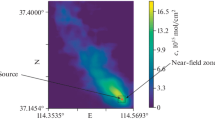Abstract
We address the nonlinear inverse source problem, which consists in identifying the time limit from which some unknown sources in a two-dimensional advection–dispersion-reaction equation become inactive. Under some reasonable assumptions and without requiring any a priori information about the form of the involved unknown sources, we prove the identifiability of the desired time active limit. We establish an identification method based on some boundary null controllability results that uses the records of the associated state on the outflow boundary and of its flux on the inflow boundary of the monitored domain to determine the time active limit. The application of this method to the most encountered forms of surface water pollution sources leads us to determine also lower and upper bounds that provide a significant approximation of the total amount loaded by the involved unknown sources without requiring any a priori information either on the number of active sources or on the form of their time-dependent intensity functions. Some numerical experiments on a variant of the surface water biological oxygen demand pollution model are presented.



Similar content being viewed by others
References
Hamdi A (2012) Inverse source problem in a 2D linear evolution transport equation: detection of pollution sources. Inverse Prob Sci Eng 20(3):401–421
Cannon JR (1968) Determination of an unknown heat source from overspecified boundary data. SIAM J Numer Anal 5:275–286
Engl HW, Scherzer O, Yamamoto M (1994) Uniqueness of forcing terms in linear partial differential equations with overspecified boundary data. Inverse Prob 10:1253–1276
Yamamoto M (1994) Conditional stability in determination of densities of heat sources in a bounded domain, International Series of Numerical Mathematics, vol 18. Birkhuser, Basel
Sakamoto K, Yamamoto M (2012) Inverse source problem with a final overdetermination for a fractional diffusion equation. Math Control Relat Fields 1(4):509–518
Hettlich F, Rundell W (2001) Identification of a discontinuous source in the heat equation. Inverse Prob 17:1465–1482
Rap A, Elliott L, Ingham DB, Lesnic D, Wen X (2006) An inverse source problem for the convection–diffusion equation. Int J Numer Methods for Heat & Fluid Flow 16(2):125–150
Hamdi A, Mahfoudhi I (2012) Inverse source problem in a one-dimensional evolution linear transport equation with spatially varying coefficients. Inverse Prob Sci Eng 21(6):1007–1031
Hamdi A, Mahfoudhi I (2015) Inverse source problem based on two dimensionless dispersion-current functions in 2D evolution transport equations with spatially varying coefficients. J Inverse Ill-Posed Prob 4:59–94
Andrle M, Belgacem FB, El Badia A (2011) Identification of moving pointwise sources in an advection–dispersion-reaction equation. Inverse Prob 27:025007
Belgacem FB (2012) Identifiability for the pointwise source detection in Fishers reaction–diffusion equation. Inverse Prob 28:065015
Belgacem FB (2012) Uniqueness for an ill-posed reaction-dispersion model. Application to organic pollution in stream-waters (one-dimensional model). Inverse Prob Imaging 6–2:163–181
APHA (1998) Standard methods for the examination of water and wastewater, 18th edn. American Public Health Association, Washington, DC
Bear J, Bachmat Y (1991) Introduction to modeling of transport phenomena in porous media. Kluwer Academic Publishers, Dordrecht, pp 553–574
Cox BA (2003) A review of currently available in-stream water-quality models and their applicability for simulating dissolved oxygen in lowland rivers. The science of the total environment 314–316:335–377
Fardin B, Mohammah HH (2010) Pollution and water quality of the Beshar River. World Acad Sci Eng Technol 4(70):10–22
Myung EL, Il Won S (2007) Analysis of pollutant transport in the Han River with tidal current using a 2D finite element model. J Hydro-environ Res 1(1):30–42
Oelkers EH (1996) Physical and chemical properties of rocks and fluids for chemical mass transport calculations in reactive transport in porous media. Lichtner, Steefel and Oelkers, The Mineralogical Society of America, Washington, DC
Lions JL (1988) Contrôlabilité exacte, perturbations et systémes distribués, Tome 1. Rech Math Appl 8, Masson, Paris
Lions JL (1988) Exact controllability, stabilization and pertubations for distributed systems. SIAM Rev 30(1):1–68
Rasmussen JM (2004) Boundary control of linear evolution PDEs-continuous and discrete, PhD dissertation, Technical University of Denmark
Lin FH (1990) A uniqueness theorem for parabolic equations. Commun Pure Appl Math 43:125–136
Fischer HB, List EG, Koh RCY, Imberger J, Brooks NH (1979) Mixing in inland and coastal waters. Academic Press, New York
Author information
Authors and Affiliations
Corresponding author
Rights and permissions
About this article
Cite this article
Hamdi, A., Mahfoudhi, I. & Rejaiba, A. Identification of time active limit with lower and upper bounds of total amount loaded by unknown sources in 2D transport equations. J Eng Math 97, 101–117 (2016). https://doi.org/10.1007/s10665-015-9799-5
Received:
Accepted:
Published:
Issue Date:
DOI: https://doi.org/10.1007/s10665-015-9799-5
Keywords
- Advection–dispersion-reaction equations
- Boundary null controllability
- Nonlinear inverse source problem
- Surface water pollution




